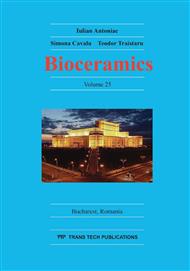[1]
M. Bächle, F Butz, U. Hübner, E. Bakalinis, R. J. Kohal, Behavior of CAL72 osteoblast-like cells cultured on zirconia ceramics with different surface topographies,. Clinical Oral Implants Research. 18 (2006) 7.
DOI: 10.1111/j.1600-0501.2006.01292.x
Google Scholar
[2]
T. J. Webster, R. W. Siegel, R. Bizios, Osteoblast adhesion on nanophase ceramics. Biomaterials. 20 (1999) 1221-1227.
DOI: 10.1016/s0142-9612(99)00020-4
Google Scholar
[3]
T. J. Webster, C. Ergun, R. H. Doremus, R. Bizios, Specific proteins mediate enhanced osteoblast adhesion on nanophase ceramics. Journal of Biomedical Research. 51 (2000) 475-483.
DOI: 10.1002/1097-4636(20000905)51:3<475::aid-jbm23>3.0.co;2-9
Google Scholar
[4]
T. J. Webster, C. Ergun, R. H. Doremus, R. W. Siegel, R. Bizos, Enhanced functions of osteoblasts on nanophase ceramics. Biomaterials. 21 (2000) 1803-1810.
DOI: 10.1016/s0142-9612(00)00075-2
Google Scholar
[5]
M. Arin, M., H. Yazici, G. Goller, Biocompability Properties of ZrO(2) Ceramics and ZrO(2)-TiN Composites. Bioceramics 21. 396-398 (2009) 51-54.
DOI: 10.4028/www.scientific.net/kem.396-398.51
Google Scholar
[6]
S. Lee, T. Kasuga, K. Kato, Effects of Y2O3 particle size on cytotoxicity and cell morphology. J. Cer. Soc. Jap. 6 (2010) 428-433.
DOI: 10.2109/jcersj2.118.428
Google Scholar
[7]
X. Luo, Z. Gao, S. Yan, W. Deng, W. Zhang, W. Yan, Functional behaviour of human periodontal ligament cells around various dental implants. Key Engineering Materials. 361-363 (2008) 837-840.
DOI: 10.4028/www.scientific.net/kem.361-363.837
Google Scholar
[8]
A. J. Dulgar-Tulloch, R. Bizios, R. W. Siegel, Human mesenchymal stem cell adhesion and proliferation in response to ceramic chemistry and nanoscale topography. J. Biomed. Mat. Res. Part A. 90A (2009) 586-594.
DOI: 10.1002/jbm.a.32116
Google Scholar
[9]
D. Yamashita, K. Kanabara, M. Machigashira, M. Miyamoto, H. Sato, Y. Izumi, S. Ban, Proliferation of osteoblast-like cells on Zirconia/Alumina nanocomposite. Key Engineering Materials. 361-363 (2007) 1099-1102.
DOI: 10.4028/www.scientific.net/kem.361-363.1099
Google Scholar
[10]
S.T. Affaffatato, R. Taddei, P. Rocchi, M. Fagnano, C. Ciapetti, G. Toni, Advanced Nanocomposite Materials for Orthopaedic Applications. I. A Long-Term In Vitro Wear Study of Zirconia-Toughened Alumina. J. Biomed. Mat. Res. Part B: Applied Biomaterials. 78B (2005).
DOI: 10.1002/jbm.b.30462
Google Scholar
[11]
D. J. Kim, et al., Cellular response assessment to zirconia-alumina composite: An in vitro experimental study. Bioceramics18. 309-311 (2006) 433-436.
DOI: 10.4028/www.scientific.net/kem.309-311.433
Google Scholar
[12]
X. He, et al., Zirconia toughened alumina ceramic foams for potential bone graft applications: fabrication, bioactivation, and cellular responses. J. Mat. Sci. Mat. Med. 19 (2008) 2743-2749.
DOI: 10.1007/s10856-008-3401-x
Google Scholar
[13]
O. Roualdes, et al., In vitro and in vivo evaluation of an alumina-zirconia composite for arthroplasty applications. Biomaterials. 31 (2010) 2043-(2054).
DOI: 10.1016/j.biomaterials.2009.11.107
Google Scholar
[14]
M. Hashiguchi, et al., Effect of surface treatments on bonding strength of zirconia to dental cements. Bioceramics 21 396-398 (2009) 575-578.
DOI: 10.4028/www.scientific.net/kem.396-398.575
Google Scholar
[15]
D. J. Kim, et al., Zirconia/alumina composite dental implant abutments. Bioceramics16 254-2 (2004) 699-702.
Google Scholar
[16]
S. Zhang, et al., Biological Behavior of Osteoblast-like Cells on Titania and Zirconia Films Deposited by Cathodic Arc Deposition. Biointerphases. 2012 Dec; 7(1-4): 60. doi: 10. 1007/s13758-012-0060-8.
DOI: 10.1007/s13758-012-0060-8
Google Scholar
[17]
OLYMPUS. Confocal laser scanning microscope LEXT OLS 3000: Manual 3. 0. (2010).
Google Scholar


